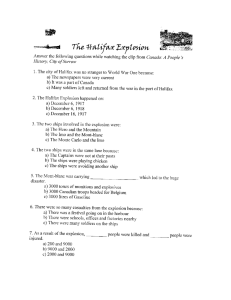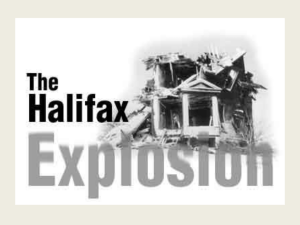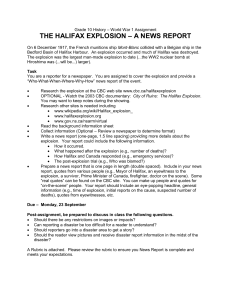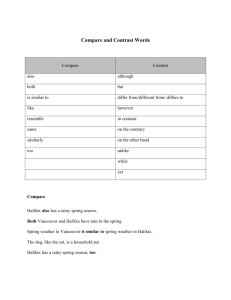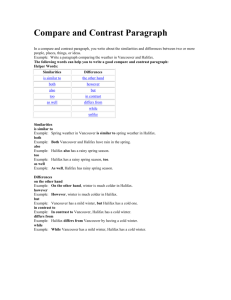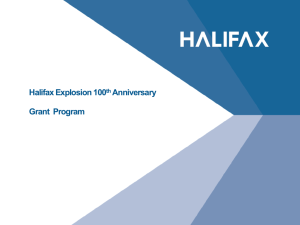Halifax explosion
advertisement
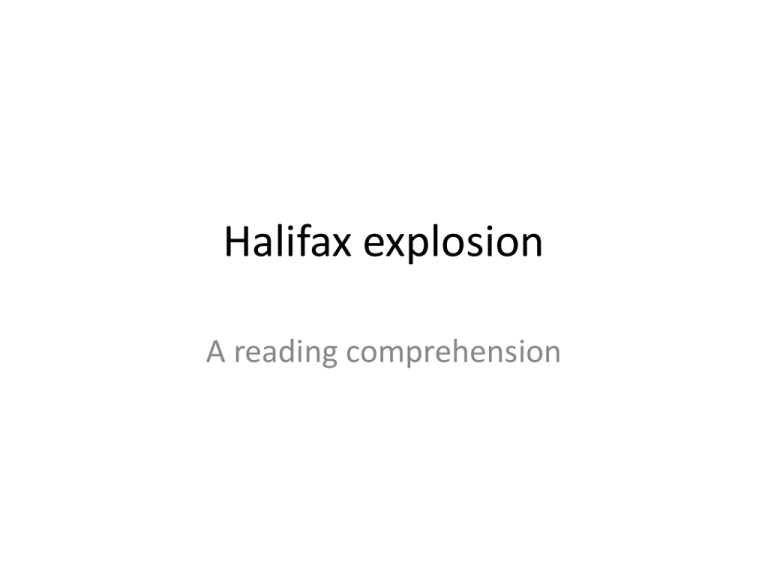
Halifax explosion A reading comprehension background • Please watch this clip before you read the article. It gives some background about the Halifax explosion. • http://www.youtube.com/watch?v=8oaRr6A-gkA Reading for understanding • This is a non-fiction Article. • Read the questions first, open a word document and copy and paste the questions into it. Put your word document in HP format.(name) • Read the article twice. Use the hi liter feature • to show where you found the answers to your questions. Questions to answer, either in word document or on paper.(name) • 1) What was going on in the world at the time of the tragedy ? • 2) What happened to Mont-Blanc after the collision? • 3) What was the irony of the tragedy ? ( don’t know what irony means. Check one of the slides ahead) The Halifax Explosion • December 6,1917 is a date that all schoolchildren in Nova Scotia most likely know about. On this day in Halifax, a 3121-ton French freighter called Mont-Blanc was entering th city’s lovely harbour. It was part of a convoy of ships that had come from New York City, and was on its way back to France. • It was filled with munitionsover 2600 tonnes of highly explosive chemicals such as nitrocellulose,TNT,wet and dry picric acid, and benzol. It was the time of World War 1. • A Norwegian vessel, Imo, was also in the harbour. It had been delayed from leaving the day before. Because a third shipwas blocking the right channel, Photo of the Imo • the captain of the Imo decided to leave the harbour through the left channel , where the Mont-Blanc was coming through. Despite attempts of both captains to avoid a collision, the two ships collided in the centre channel. The result was Photo: the explosion in the Halifax harbour. • The largest artificial explosion before the atomic bomb in 1945. Mont-blanc became a fireball that rose over a mile in the air. The ship vaporized. The force of the explosion caused a tsunami 18 metres high, throwing the Imo onto the land. A wave of pressure snapped trees and demolished buildings for kilometres. Captions for photos, top: overlooking the devastation of collapsed buildings .Below: hospital • Over 1000 people died instantly, another thousand died later, and 6000 people were seriously injured. Because many of the residents in Halifax had been looking at the harbour through their windows, they were blinded by flying glass when Mont-Blanc exploded. The entire north end of the city was destroyed and 1500 people were left homeless by the destruction. Even in Truro, which is many kilometres away, windows were shattered. Property damage was estimated to be over $30 million, which was a huge amount in 1917. Summary • Ironically, the large number of eye injuries led to medical advances in the treatment of such injuries. • Even today, nearly a century later, what happened at Halifax Harbour on that fateful day in December ranks as one of the largest man-made, non-nuclear explosions ever to occur. What is Irony ? • http://www.scholastic.com/browse/article.jsp ?id=3756542 Finished ? • Work on your three questions. Mrs. Guilfoyle has a hand out for you as well .The questions must be done before the end of today’s class. • If you still have time left you may view the links below. • http://www.cbc.ca/halifaxexplosion/he7_teachers/Doc uComic_HFDsm.pdf • http://www.cbc.ca/halifaxexplosion/he7_teachers/ind ex.html • http://www.youtube.com/watch?v=e3DU95ZLxw8
